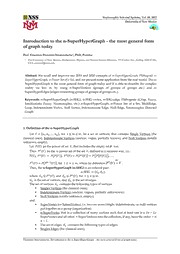
Introduction to the n-SuperHyperGraph - the most general form of graph today PDF
Preview Introduction to the n-SuperHyperGraph - the most general form of graph today
Neutrosophic Sets and Systems, Vol. 48, 2022 University of New Mexico Introduction to the n-SuperHyperGraph - the most general form of graph today Prof. Emeritus Florentin Smarandache1, PhD, Postdoc 1 The University of New Mexico, Mathematics, Physics, and Natural Science Division, 705 Gurley Ave., Gallup, NM 87301, USA; [email protected] Abstract: We recall and improve our 2019 and 2020 concepts of n-SuperHyperGraph, Plithogenic n- SuperHyperGraph, n-Power Set of a Set, and we present some application from the real world. The n- SuperHyperGraph is the most general form of graph today and it is able to describe the complex reality we live in, by using n-SuperVertices (groups of groups of groups etc.) and n- SuperHyperEdges (edges connecting groups of groups of groups etc.). Keywords: n-SuperHyperGraph (n-SHG), n-SHG-vertex, n-SHG-edge, Plithogenic (Crisp, Fuzzy, Intuitionistic Fuzzy, Neutrosophic, etc.) n-SuperHyperGraph, n-Power Set of a Set, MultiEdge, Loop, Indeterminate Vertex, Null Vertex, Indeterminate Edge, Null Edge, Neutrosophic Directed Graph 1.Definition of the n-SuperHyperGraph Let 𝑉 ={𝑣 ,𝑣 ,…,𝑣 }, for 1≤𝑚 ≤∞, be a set of vertices, that contains Single Vertices (the 1 2 𝑚 classical ones), Indeterminate Vertices (unclear, vague, partially known), and Null Vertices (totally unknown, empty). Let 𝑃(𝑉) pe the power of set 𝑉, that includes the empty set too. Then 𝑃𝑛(𝑉) be the 𝑛-power set of the set 𝑉, defined in a recurent way, i.e.: P(V), 𝑃2(𝑉) = 𝑃(𝑃(𝑉)), 𝑃3(𝑉)=𝑃(𝑃2(𝑉))=𝑃(𝑃(𝑃(𝑉))), …, def 𝑃𝑛(𝑉)=𝑃(𝑃𝑛−1(𝑉)), for 1≤𝑛 ≤∞, where by definitionP0(V) V . Then, the n-SuperHyperGraph (n-SHG) is an ordered pair: n-SHG =(𝐺 ,𝐸 ), 𝑛 𝑛 where 𝐺 ⊆𝑃𝑛(𝑉), and 𝐸 ⊆𝑃𝑛(𝑉), for 1≤𝑛≤∞. 𝑛 𝑛 𝐺 is the set of vertices, and 𝐸 is the set of edges. 𝑛 𝑛 The set of vertices 𝐺 contains the following types of vertices: 𝑛 Singles Vertices (the classical ones); Indeterminate Vertices (unclear, vagues, partially unkwnown); Null Vertices (totally unknown, empty); and: SuperVertex (or SubsetVertex), i.e. two ore more (single, indeterminate, or null) vertices put together as a group (organization). n-SuperVertex that is a collection of many vertices such that at least one is a (𝑛−1)- SuperVertex and all other 𝑟-SuperVertices into the collection, if any, have the order 𝑟 ≤ 𝑛−1. The set of edges 𝐸 contains the following types of edges: 𝑛 Singles Edges (the classical ones); Florentin Smarandache, Introduction to the n-SuperHyperGraph - the most general form of graph today Neutrosophic Sets and Systems, Vol. 48, 2022 484 Indeterminate Edges (unclear, vagues, partially unkwnown); Null Edges (totally unknown, empty); and: HyperEdge (connecting three or more single vertices); SuperEdge (connecting two vertices, at least one of them being a SuperVertex); 𝑛-SuperEdge (connecting two vertices, at least one being a 𝑛-SuperVertex, and the other of order 𝑟-SuperVertex, with 𝑟≤𝑛); SuperHyperEdge (connecting three or more vertices, at least one being a SuperVertex); 𝑛-SuperHyperEdge (connecting three or more vertices, at least one being a 𝑛- SuperVertex, and the other 𝑟-SuperVertices with 𝑟 ≤𝑛; MultiEdges (two or more edges connecting the same two vertices); Loop (and edge that connects an element with itself). and: Directed Graph (classical one); Undirected Grpah (classical one); Neutrosophic Directed Graph (partially directed, partially undirected, partially indeterminate direction). 2.SuperHyperGraph When n = 1 we call the 1-SuperHyperGraph simply SuperHyperGraph, because only the first power set of V is used, P(V). 3.Examples of 2-SuperHyperGraph, SuperVertex, IndeterminateVertex, SingleEdge, Indeterminate Edge, HyperEdge, SuperEdge, MultiEdge, 2-SuperHyperEdge [2] IE7, 8 is an Indeterminate Edge between single vertices V7 and V8, since the connecting curve is dotted; IV9 is an Indeterminate Vertex (since the dot is not filled in); while ME5,6 is a MultiEdge (double edge in this case) between single vertices V5 and V6. Florentin Smarandache, Introduction to the n-SuperHyperGraph - the most general form of graph today Neutrosophic Sets and Systems, Vol. 48, 2022 485 4.Types of n-SuperHyperGraphs The attributes values degrees of appurtenance of a vertex or an edge to the graph may be: crisp / fuzzy / intuitionistic fuzzy / picture fuzzy / spherical fuzzy / etc. / neutrosophic / refined neutrosophic / degrees with respect to each n-SHG-vertex and to each n-SHG-edge respectively. For example, one has: 5.Plithogenic n-SuperHyperGraph We recall the Plithogenic n-SuperHyperGraph. A Plithogenic n-SuperHyperGraph (n-PSHG) is a n-SuperHyperGraph whose each n-SHG-vertex and each n-SHG-edge are characterized by many distinct attributes values (a1, a2, …, ap), p ≥ 1. Therefore one gets n-SHG-vertex(a1, a2, …, ap) and n-SHG-edge(a1, a2, …, ap). 6.Plithogenic Fuzzy-n-SHG-vertex (a1(t1), a2(t2), …, ap(tp)) and Fuzzy-n-SHG-edge(a1(t1), a2(t2), …, ap(tp)); 7.Plithogenic Intuitionistic Fuzzy-n-SHG-vertex (a1(t1, f1), a2(t2, f2), …, ap(tp, fp)) and Intuitionistic Fuzzy-n-SHG-edge(a1(t1, f1), a2(t2, f2), …, ap(tp, fp)); 8.Plithogenic Neutrosophic-n-SHG-vertex (a1(t1, i1, f1), a2(t2, i2, f2), …, ap(tp, ip, fp)) and Neutrosophic-n-SHG-edge (a1(t1, i1, f1), a2(t2, i2, f2), …, ap(tp, ip, fp)); etc. Whence in general we get: 9.The Plithogenic (Crisp / Fuzzy / Intuitionistic Fuzzy / Picture Fuzzy / Spherical Fuzzy / etc. / Neutrosophic / Refined Neutrosophic) n-SuperHyperGraph 10.Conclusions The n-SuperHyperGraph is the most general for of graph today, designed in order to catch our complex real world. First, the SuperVertex was introduced in 2019, then the SuperHyperGraph constructed on the power set P(V), and further on this was extended to the n-SuperHyperGraph built on the n-power set of the power set, Pn(V), in order to overcome the complex groups of individuals and the sophisticated connections between them. References 1. Florentin Smarandache, n-SuperHyperGraph and Plithogenic n-SuperHyperGraph, in Nidus Idearum, Vol. 7, second and third editions, Pons, Bruxelles, pp. 107-113, 2019, http://fs.unm.edu/NidusIdearum7- ed3.pdf. 2. Florentin Smarandache, Extension of HyperGraph to n-SuperHyperGraph and to Plithogenic n- SuperHyperGraph, and Extension of HyperAlgebra to n-ary (Classical-/Neutro-/Anti-) HyperAlgebra, Neutrosophic Sets and Systems, vol. 33, 2020, pp. 290-296. DOI: 10.5281/zenodo.3783103, http://fs.unm.edu/NSS/n-SuperHyperGraph-n-HyperAlgebra.pdf (accessed 02/13/2022). Received: January 18, 2022. Accepted: February 10, 2022. Florentin Smarandache, Introduction to the n-SuperHyperGraph - the most general form of graph today
